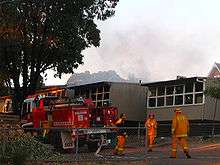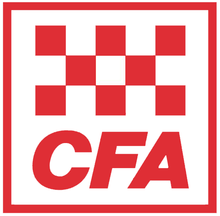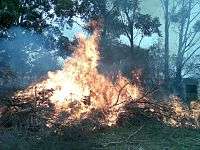Country Fire Authority
|
Official seal and emblem of the Country Fire Authority | |
| Established | 1945 |
|---|---|
| Location | |
Region served | CFA has a State headquarters and 5 regions across Victoria. Within these regions are 21 CFA districts.[1] |
| Services | Combatant authority for fire, rescue and hazmat |
Members | 1219 brigades[2] |
Staff | 2300+ paid staff including 1000+ career firefighters |
Volunteers | 30000+ |
| Website | www.cfa.vic.gov.au |
Country Fire Authority, more commonly referred to as the CFA, is one of the fire services in Victoria, Australia, the others being Department of Environment, Land, Water and Planning (DELWP) and the Metropolitan Fire Brigade (MFB). The CFA provides firefighting and other emergency services to rural areas and regional townships of Victoria, as well as the portions of the outer suburban areas of Melbourne not covered by the MFB. In the event of emergency in Australia, emergency services including the CFA can be called by dialling Australia's primary emergency service number, 000 or the secondary emergency service number of 112 which can only be dialled on a digital mobile phone.
CFA has a workforce of more than 30,000 volunteer firefighters from local communities all around Victoria. These volunteers are backed up by more than 1,000 career (staff) firefighters. Stations manned on a full-time basis are called "integrated fire stations", with Career Firefighters and Volunteers working together. CFA works closely with the other emergency services, such as the MFB, the State Emergency Service, Victoria Police and Ambulance Victoria.
CFA falls under the portfolio of the Minister for Emergency Services, The Honourable James Merlino, who took on this role on 10 June 2016.[3] In 2016, Frances Diver was appointed Chief Executive Officer of CFA, commencing her role on 27 June 2016.[4] CFA's current Chief Officer is Steve Warrington, promoted from his previous position as Deputy Chief Officer.[5]
History
The CFA was created on 2 April 1945 following significant bushfires during the period 1939-1944 which killed 114 people, destroyed nearly 1400 homes and damaged large areas of the state. Significant numbers of livestock also perished. Subsequent investigations showed a lack of cohesive firefighting ability outside the central metropolitan area. The CFA took over existing brigades, many of which had been established in the 19th or early 20th century.[6]
The CFA operates under the Country Fire Authority Act of 1958, as amended, and its Regulations.
Funding

Since July 2013, fire services in Victoria have been funded by a fire service property levy on council rates. The CFA budgeted income for 2013–14 was $473m—$448m was provided by state government contributions, and $25m was internally generated (fees and charges, interest, donations, and sales of goods and services).[7]
The CFA also receives some funding from the provision of goods and services to external bodies. Additional funding from the government is provided during long-duration bushfires. Individual brigades receive further funds from local councils, from their own fundraising activities and from donations from the community. Some fire brigades hold large amounts of community funds and investments. This money funds competitions between local and interstate brigades and can also be used to purchase equipment.
CFA structure
Regions and districts
The CFA field of operations in Victoria covers an area of more than 150,000 square kilometres with a population of 3.3 million people. It divides its operations into 5 regions, which are then subdivided into 21 districts.[8] The CFA regions are:
- Loddon Mallee Region (North West)—districts 2, 14, 18 & 20
- Grampians Region (West)—districts 15, 16 & 17
- Barwon South-West Region (South West)—districts 4, 5, 6 & 7
- Hume Region (North East)—districts 12, 13, 22, 23 & 24
- Gippsland Region (South East)—districts 8, 9, 10, 11 & 27.
Fire brigades and resources

The CFA currently employs about 1,000 career firefighters in heavily urbanised or more densely populated areas, 1,100 support staff, and can draw on approximately 30,000 volunteer firefighters from local communities, as needed.
The CFA boasts 1,219 brigades, of which 941 are rural volunteer brigades, 204 are urban volunteer brigades, 35 are integrated brigades (manned by career firefighters and volunteers), 23 forest industry brigades, and 17 coast guard brigades.[9] The CFA's integrated fire brigades are in Ballarat City, Belmont, Bendigo, Boronia, Caroline Springs, Corio, Craigieburn, Cranbourne, Dandenong, Eltham, Frankston, Geelong City, Greenvale, Hallam, Hoppers Crossing, Melton, Mildura, Mornington, Morwell, Ocean Grove, Pakenham, Patterson River, Point Cook, Portland, Rosebud, Rowville, Shepparton, South Morang, South Warrandyte, Springvale, Sunbury, Traralgon, Wangaratta, Warrnambool, and Wodonga.[10]
The CFA operates more than 4,000 vehicles, including 1,970 4WD tankers, 264 pumpers, 11 hydraulic platform (aerial) trucks, 28 rescue tenders, 16 hazmat vehicles plus numerous other vehicles including communications vans, lighting trucks, support and transport vehicles. This fleet is supplemented by more than 1,400 brigade-owned vehicles. Brigade-owned vehicles are bought and paid for by individual brigades and by communities, sometimes with the assistance of government grants.
The CFA has 1,200 base radios, 5,800 vehicle radios, 3,000 hand held radios, 35,000 EAS pagers, 58 satellite terminals and 10,700 pre-conference telephone interceptors.[10]
Coast guard brigades
In 2005, the CFA signed a Memorandum of Understanding with the Australian Volunteer Coast Guard to establish CFA coast guard brigades.[11] Under the MoU, all Victorian coast guard vessels will have CFA radios installed, EAS (Emergency Alerting System) pagers as used by the CFA as well as basic firefighting tools including a small pump and hoses.[12] Additionally all coast guard members are to receive basic CFA firefighting training and some land brigades will receive marine firefighting training.[10]
Communications
In Victoria, the Emergency Services Telecommunications Authority (ESTA) provides dispatch and call-taking services for Police, Ambulance, State Emergency Service and both rural and metropolitan fire services. ESTA operates over three sites, located in Melbourne CBD, East Burwood, and Mount Helen, in Ballarat.
Many ESTA practices and protocols are standardised across all emergency services, allowing all agencies to utilise the same computer network. This enables complete and instantaneous information sharing between emergency services.[13]
When a caller dials 000 for emergency response within Victoria, a Telstra operator will connect them to the relevant ESTA facility, where call-takers collect information from the caller for entry into the Computer Aided Dispatch (CAD) system. Using this information, a dispatcher will respond the appropriate emergency resources. Services are often already being notified by the dispatcher while the call-taker is still obtaining further information or giving advice, such as guiding the caller through CPR (Cardiopulmonary resuscitation).
When ESTA is notified of a fire or incident, they send an emergency message via pager to volunteers or career firefighters. While this is usually the result of a call to 000, brigades or appliances may also be dispatched by other agencies such as Victoria Police or Ambulance Victoria, or at the request of an Incident Controller on scene. Brigades are dispatched based on various factors including the time of day, location and type of fire or incident. Although each fire brigade has a primary response area, neighbouring brigades or specific appliances may be dispatched as support to the primary brigade. This is especially the case where specialist skills or equipment are needed, such as for road accident rescue or large structural fires.
ESTA is also responsible for Victoria's State Emergency Service call-taking and dispatch for non life-threatening storm damage or flooding via 132 500.[14]
Fire districts
Victoria is divided into nine fire districts:[15]
- Mallee
- Wimmera
- South West
- Northern Country
- North Central
- Central
- North East
- East Gippsland
- West and South Gippsland.
The CFA announces fire danger ratings, total fire ban declarations and fire restrictions, which apply to all municipalities within a fire district:
- The Fire Danger Ratings are forecast for four days.
- A Total Fire Ban is declared for each district by CFA on days when fires are likely to spread rapidly and could be difficult to control, and means that no fires can be lit for the declared district for that day—irrespective of the Fire Restriction status for a given municipality.
- Fire Restrictions come into force when entered into the Government Gazette.
Operational Ranks
Not all CFA ranks are listed.
| Operational Rank | Membership Type (Staff/Volunteer) |
|---|---|
| Chief Officer | Staff |
| Assistant Chief Officer | Staff |
| Operations Manager | Staff |
| Operations Officer | Staff |
| Senior Station Officer | Staff |
| Station Officer | Staff |
| Leading Firefighter | Staff |
| Qualified Firefighter | Staff |
| Firefighter | Staff/Volunteer |
| Captain | Volunteer |
| Lieutenant | Volunteer |
| Group Officer | Volunteer |
| Deputy Group Officer | Volunteer |
Training
"CFA's regional training campuses provide our members with the opportunity to experience operational scenarios, including live fires, in a safe, controlled and realistic environment.
This is essential in developing and maintaining the skills our members need to fulfil our mission of protecting the lives and property of Victorian communities."[16]
The CFA operates seven Regional Training Campuses:
Career firefighters are employed following an exhaustive selection process, and must complete their initial station-based probationary learning period, followed by 4 years of practical and theory subjects relevant to the occupation. Firefighters achieving this level with sufficient subject marks, are promoted to the rank of Qualified Firefighter. They may then commence studies for assessment and promotion to the ranks of Leading Firefighter, Station Officer and Senior Station Officer.
All Volunteer members are required to undertake Wildfire "minimum skills" training before being passed as competent to respond to fire and emergency calls. "Minimum Skills" consists of the following training modules:[17]
- PUAFIR201 - Prevent Injury
- PUAOHS002 - Maintain Safety at an Incident Scene
- PUAFIR204 - Respond to Wildfire
- PUAFIR309 - Operate Pumps
- PUAOPE002 - Operate Communication Systems and Equipment
- PUATEA001 - Work in a Team
Major incidents
The CFA has been involved in a number of major fires over the years where lives have been lost, including:
- Black Friday
- Ash Wednesday fires in 1983
- Linton bushfire in 1998
- The Victorian Alps fires in 2003 and 2007.
- The Black Saturday bushfires in 2009
The CFA has also been involved in combatting interstate fires such as the Sydney fires in 2002 and the 2003 Canberra bushfires. In late 2015, CFA firefighters were deployed to the South Australian fires, in support of CFS and SAFS crews. During February and March 2016, hundreds of CFA volunteer and career firefighters were deployed across Bass Strait, where they relieved assisted Tasmanian FS firefighters working on the NorthWest Tasmanian fires. Many CFA firefighting and specialist vehicles were ferried over as well.
Activities
The CFA is involved in other non-firefighting operations. The CFA has a leading role in Prevention, Preparedness, Response and Recovery of Fires and other Incidents.[18] The CFA is responsible for all fires on Private land in Victoria outside of the Metropolitan Fire District including Structure Fires and Bushfires. The CFA has a shared responsibility for Rescues with the Victorian State Emergency Service. In addition to its response activities, members also run prevention programs such as Fire Ready Victoria[19] and Fire Safe Kids. Fire Safe Kids is an education program for Pre-Primary and Primary School students which teaches Fire Safety and the Role of Firefighters in the Community.[20]

The CFA is responsible for specialist response functions, including:
- Confined Space Rescue
- Trench Rescue
- High Angle Rescue
- Road Accident Rescue
- Industrial Rescue
- Urban Search and Rescue (USAR)
- Aviation Response
- Marine Response
- Hazardous Materials Response
- Chemical, Biological, Radiological (CBR) Response
CFA have been involved, for several years, in trials to evaluate provision of EMR (Emergency Medical Response) services to "Signal 0" medical emergencies. Most of these trials were carried out by selected Volunteer Fire Brigades. CFA have subsequently decided to continue with EMR responses. By 4th October 2016, nearly all Integrated Stations were responding career firefighters to "Signal 0" (Non-breathing/Non-responsive) medical emergencies, supporting Ambulance Victoria crews. Some Volunteer Brigades also provide EMR response capability.
Representative Bodies
Volunteer Fire Brigades Victoria (VFBV) was established under the Country Fire Authority Act 1958 to represent volunteer fire brigades and work with CFA and the Victorian Government to ensure ongoing commitment to the principles outlined by the Volunteer Charter.[21]
The Victorian Branch of the United Firefighters Union of Australia (UFU) was established January 22 1911 and represents career firefighters throughout Victoria.[22] Volunteer firefighters may join the UFU as associate members. The UFU funds valuable research into firefighting technologies which benefit both career/volunteer firefighters. In November 0f 2016, a third representative body came into being. The Victorian Volunteer Firefighters Association (VVFA) was formed to represent individual volunteer firefighters, a move stemming from recognition that the VFBV focus on brigades as a whole rather than on individual volunteer members.
Championships
In addition to championing the cause of volunteer fire brigades and their many vital operational needs, VFBV organise, promote and conduct the Urban and Rural State Fire Brigade Championships. In this series of sporting heats, Volunteer brigades compete in events based on past, and some current firefighting practices. In 2017, the Rural State Championships will be held at Wodonga, on April 1 & 2. The 2017 State Junior Championships will be held at Tatura, on February 25 & 26. The State Urban Championships will return to Bendigo for the Labour Day weekend in 2017, after travelling to Mildura in 2016.[23]
See also
- Metropolitan Fire Brigade
- New South Wales Rural Fire Service
- South Australian Country Fire Service
- New South Wales Fire Brigades
- Australasian Fire Authorities Council
- List of Country Fire Authority brigades
- CFA Training College, Fiskville
- Australasian Fire and Emergency Service Authorities Council
References
- ↑ Contact Us (accessed 25 August 2016)
- ↑ CFA at a Glance(as at 01/07/2016)
- ↑ Parliament of Victoria - Ministers Database (accessed 7.06 PM 17 June, 2016)
- ↑ Appointment of new CFA CEO (accessed 7.06 PM 17 June, 2016)
- ↑ CO Steve Warrington message (accessed 4.17 PM 28 July, 2016)
- ↑ History - Country Fire Authority (accessed 30 September 2015)
- ↑ CFA Funding
- ↑ Editor Sigley, G. (2008). Brigade Magazine, Winter Edition. Country Fire Authority.
- ↑ http://www.cfa.vic.gov.au/about/stations/#sthash.YExSuSkP.dpuf
- 1 2 3 CFA Annual Report 2013. Accessed 10 April 2010
- ↑ Conference Proceedings Website. Accessed 21 November 2008
- ↑ CFA Annual Report 2008 - Operations Report. Accessed 21 November 2008
- ↑ "Centralised service for triple-0 calls". 30 November 2012. Retrieved 1 December 2012.
- ↑ Emergency Call-Taking & Dispatch Accessed 06 October 2016
- ↑ Find your fire district
- ↑ Training Campuses Environmental Management & Safety Accessed 06 October 2016
- ↑ [Bushfire Firefighter Reference Manual Edition 1 February 2011]
- ↑ CFA Annual Report Report of Operations Accessed 21 November 2008
- ↑ Fire Ready Victoria Accessed 21 November 2008
- ↑ Fire Safe Kids Accessed 06 October 2016
- ↑ Our Role VFBV 29 July 2016
- ↑ 100 Years of the United Firefighters Union UFU Victoria 22 January 2011
- ↑ Upcoming Championships VFBV 23 September 2016
External links
- Official Country Fire Authority web site
- CFA Act 1958
- FIREWORLD - CFA Museum and Discovery Centre
- CFA Wiki
Related links
- Office of the Emergency Services Commissioner
- Healesville Fire Brigade
- Bayswater CFA
- Mornington Fire Brigade
- geelongwestfirebrigade-cfa.org.au
